Like for Pt. 2: Misinformation and Self-Diagnosis of ADHD on TikTok
Rachel Solis – 13900811
Mariana Vieira – 13151495
Anna Belosterkovskaya – 13454293
Alyssa Gehasse – 14050552
Introduction
As social media companies fight to stay relevant, TikTok has emerged as one of the top platforms for the younger generations. Their algorithms reinforce popular ideas and beliefs, and very strategically serve perfectly curated content to their users – often choosing popular content over accurate content. Prioritizing content this way introduces a problem with easily-spread misinformation that younger people on the platform cannot always easily detect.
Social media “has an uncanny way of making everyone feel understood for their specific, one of a kind, quirks” (Slay 2021). The ability to relate to others all around the world means that you’re likely able to find people similar to you, connect to your similarities and feel more accepted for who you are. Young people are particularly susceptible to this because teenagers are in a stage of their lives where they are looking for a stronger sense of self-identity. This, paired with the fact that over 90% of teenagers report using social media, a perfect storm for self-diagnosis is created (Slay 2021).
One particular problem we’ve seen with misinformation on the platform is self-diagnosis, and in this essay we’ll specifically address the self-diagnosis of Attention Deficit Hyperactivity Disorder (ADHD) on TikTok. In fact, the hashtag #selfdiagnosis has over 13.5 million views on TikTok (Kross Wallace 2021). Furthermore, we want to integrate different research academic papers on misinformation on social media platforms, self-diagnosis and ADHD, examining the outlines of these cases and conclude with a proposed intervention.
Context
Misinformation is known as “false content shared by a person who does not realize it is false or misinformation” (Shuet al. 2020). Misinformation has been on the academic radar for a while now. Consequences occur not only on a network level, with social media platforms being progressively associated with these detrimental characteristics, but also on a social, everyday life level, with users being deceived through dangerous directions.
TikTok has become one of more prominent and popular social media platforms in the last few years. The academic relevance lies on the lack of academic research done, due to it being a relatively new (since 2016) platform and not a lot of information related to the platforms’ algorithm being known. Their algorithm is designed so that content is distributed in a decentralized fashion, giving all users the same chances to “go viral” and gain popularity. It stands out from other big players like Facebook in that users do not have to choose their preferences, but TikTok’s algorithm will learn preferences from user habits (Wang 2020). We know that TikTok does not account for accuracy when users gain this traction on their videos, so they are encouraged to create videos that are more relatable, and likely to receive engagement, than they are encouraged to put out accurate, well-researched content.
ADHD is characterized by “high levels of hyperactive, impulsive, and inattentive behaviors that begin during early childhood, are persistent over time, pervasive across situations, and lead to clinically significant impairments” (Kings College London 2013). To receive a proper diagnosis, the symptoms of ADHD must be severe enough to impact the daily life of the diagnosed. The problem lies in that many of the symptoms can be seen as relatable, although not debilitating. “So, while you may have difficulty sustaining attention, ignore details, struggle with organization, be forgetful, lose things, and avoid tasks requiring sustained mental effort,if this does not impact your functioning or interfere with the quality of your functioning, then you do not have an attention-deficit/hyperactivity disorder (inattentive type).” (Slay 2021) Because of this, when symptoms are listed out one may identify with the symptoms and start to believe they have the disorder. In relation to the spread of ADHD on TikTok, we see many instances of users (likely unintentionally) spreading false or misleading content about the disorder in order to gain relevance and popularity on the platform.
The method we often see is a user utilizing a popular song or audio as they list out relatable characteristics of the disorder that many people could see in themselves, such as constantly losing your train of thought, being messy, feeling overwhelmed, always feeling tired, overspending money and even disliking household chores. While these are symptoms we often see in people with ADHD, they can also character traits of an individual. The issue lies in that people will watch these videos, attribute the characteristic, and then self-diagnose themselves with the disorder.
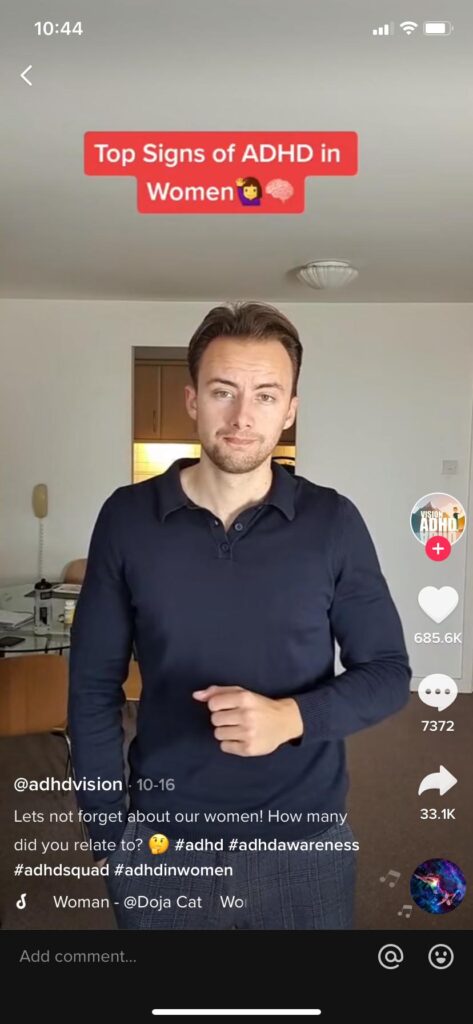
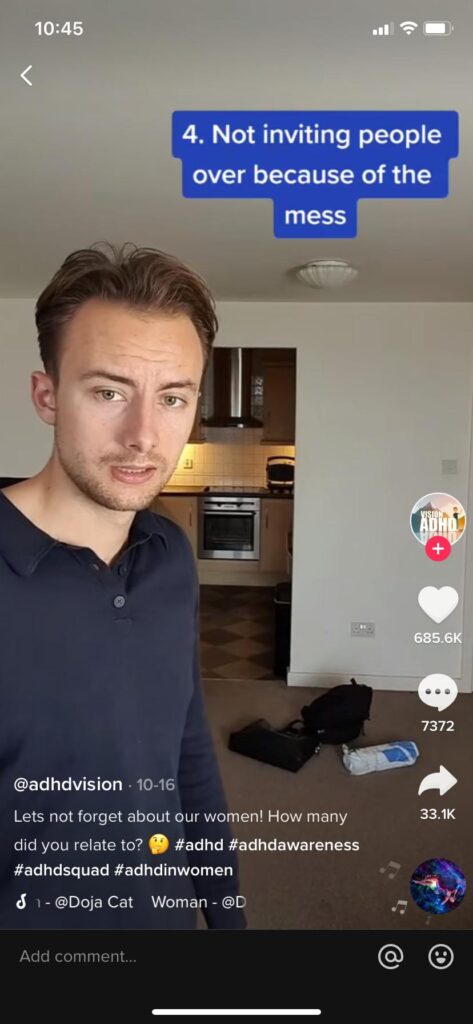

While TikTok and other platforms have been helpful in building acceptance around disorders and bringing people together for shared connections, this self-diagnosis phenomenon can be more harmful than we think.
Relevance
Why is this a problem? When you self-diagnose psychological disorders, there is a chance you could miss a medical issue that is in fact physical, but is showing psychological symptoms. We also undermine doctors when we self-diagnose, putting the relationship you have with them at risk (Pillay 2010). According to Bre-Ann Slay Psy.D, we should also consider that a rise in self-diagnosis, especially when the diagnosis is not accurate, may take away resources for those who need them. (Slay 2021)
TikTok is a platform prevalent among younger generations, in which it is used as a source of information and public discussions (Douek 2021). Perez-Escoda et al. (2021) point out that for the youngest, social online networks are a natural environment for social interactions, entertainment, information, and even education. We should focus on how potentially harmful and dangerous this phenomenon can be for younger audiences.
TikTok is aware of misinformation on its platform and the harmful results that can come from it, but has not taken sufficient measures to stop this spread. TikTok’s algorithm prioritizes popularity of content over accuracy, which results in serving popular ADHD-related videos to more people. Unfortunately, young people are more susceptible to believing the misinformation they are seeing and are less likely to be able to critically analyze the content to decide if the content is accurate or not. While TikTok can provide doctors and other health professionals an opportunity to distribute their knowledge with users who do not have access to this kind of expertise in the physical world, it simultaneously accommodates a platform for unqualified individuals to do the same.
Furthermore, health issues on the internet take a massive role in “capturing behaviours and attitudes.” (Ghenai & Mejova 2018) It is crucial to discuss these matters and evaluate the risks of online self-diagnosis. Developing the consequences of these academic debates into palpable guidelines could help reconduct the platforms towards a safer environment.
Methodology
Only when it is acknowledged that the power held within the information dispersed on social media can be harmful, is it possible to start preventing it. To identify misinformation as a recurrent issue, in this case on self-diagnosis of ADHD, and understand how to prevent it, while providing valid solutions such as reliable sources, we must characterize the problem, detect the falsity, and attribute it to the content consumed.
According to Shu et al., this three-phase method first requires the characterization of the misinformation to understand the purpose of the content to determine whether it is malevolent or inoffensive. The motive for the creation of such content could be an emotional response towards the disorder, the persuasion of other users to check for symptoms, try demystifying ADHD, or in some cases, just create a viral video. Users tend to follow relatable people and consequently “receive news promoting their existing narratives, resulting in an echo chamber effect.” (Shu et al. 2020)
Next, through detection the objective is to identify misleading information effectively, at a premature stage. By detecting the original sources, which can be difficult, it is possible to define how information propagates. For the case of ADHD diagnosis on TikTok, we have found that while symptoms typically shown are not inaccurate, they are portrayed in an ambiguous way.
The third phase, attribution, requires taking into account the origin of the information. It can be a grey area, since “social media lacks a centralized authority or mechanism that can store and certify provenance of a piece of social media data.” (Shu et al. 2020) We will dive into this further in the discussion section of this paper.
Analysis
There is a higher rate of users sharing opinions and beliefs when it aligns with what they already know about a certain subject (Stukus 2019). When somebody relates to ADHD-related symptoms, they are likely to engage with the videos and the prospect of them looking at more of these TikToks is high. “The platform logics of TikTok force internet celebrity aspirants to actively seek out, learn, participate in, and engage in these what is ‘going viral’ at the moment in order to remain visible to others on the app […]” (Abidin 2021). Due to the algorithm, ADHD TikTokers are chiming into viral trends to gain popularity such as the Put a Finger Down-challenge, meaning that if people relate to a statement, they close a finger when all the fingers are down, one may have ADHD.
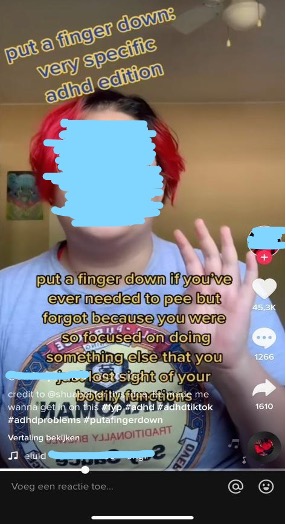
The goal of the content creator is to earn as much engagement on their TikToks as possible in the form of likes, comments, and shares to be placed on the For You Page (Abidin 2021). To increase engagement, some creators put questions in their captions so people will comment on their experiences, as seen in the example below.
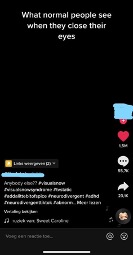

As a user engages with certain content, the algorithm will start to provide more content that falls into that same category, where users are considering these new videos as ‘second opinions’ or in this case, a further confirmation of diagnosis (Kross Wallace 2021). TikTok’s algorithms have a great impact on curating how the information flows and how that piece of information is perceived by users (Gillespie 2014). Therefore, algorithms can spread and even promote misleading and sensationalist content over factual information (Howard, Neudert, Prakash & Vosloo 2021).
With this in mind, platform regulation and moderation is one of the possible ways to combat the issue of misinformation spreading on TikTok. Because TikTok is relatively new and generally opaque with their algorithm mechanisms, there is not much transparency and accountability for the content that is hosted on the platform.
Some social media companies have started to implement features to prevent the spread of misinformation, such as Twitter, who has implemented a feature that asks if the user wants to read the article before posting it.
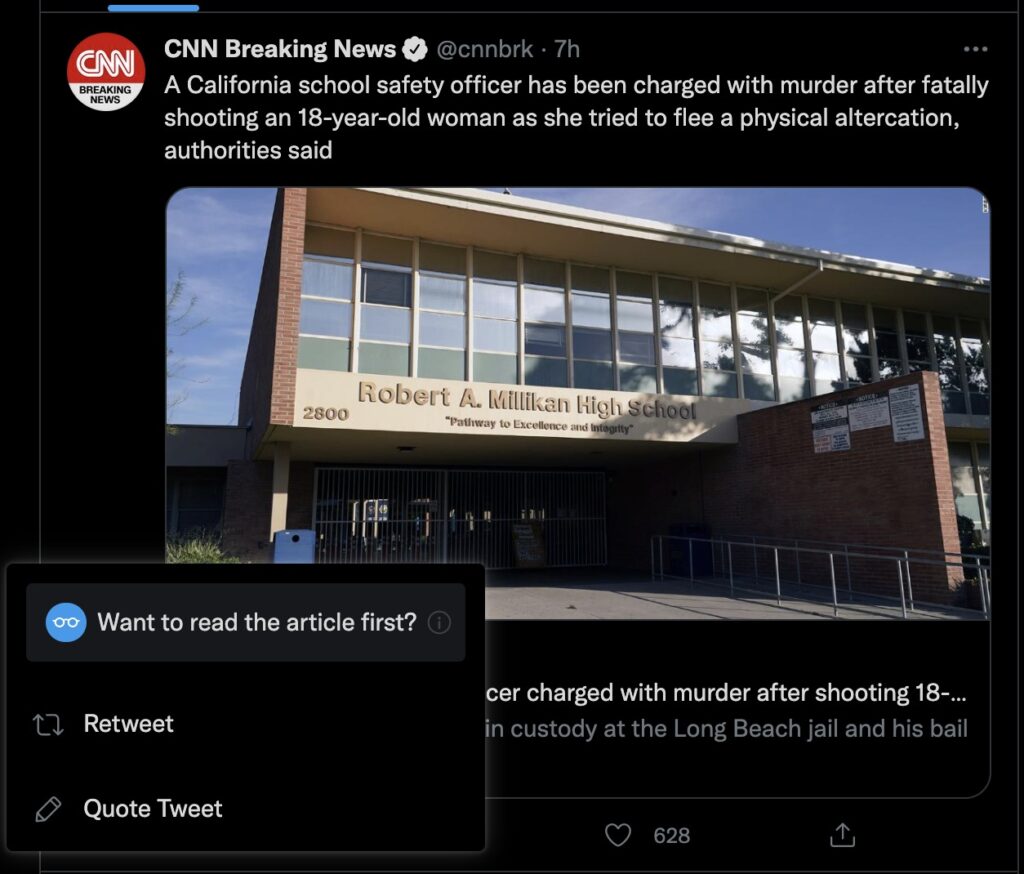
Another feature that platforms are starting to implement, such as Instagram and TikTok, is to label content related to Covid-19 in order to provide reliable sources to search information on the subject. Similar features could be added for other topics, such as ADHD, to protect younger users from the harmful effects of self-diagnosis.
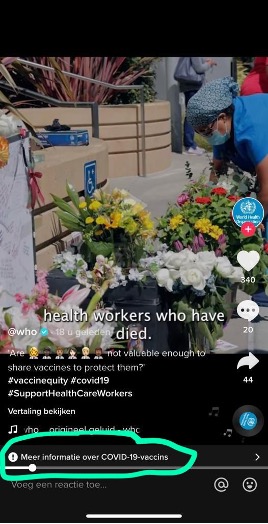

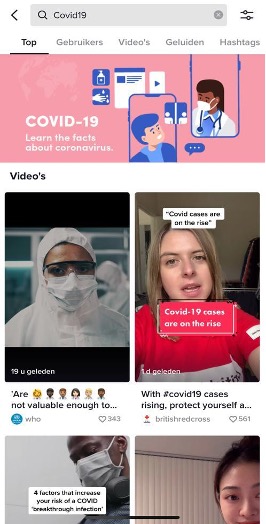
Discussion
The most challenging part of misinformation on TikTok is for users to make their own critical analysis, by identifying if the content is misleading. In this case, misinformation on ADHD may lead to incorrect self-diagnosis, unreasonable anxiety for one’s medical condition, or false expectations regarding the arranged treatment options (Stukus 2019).
It is crucial to acknowledge the prevalence of ADHD-related misinformation in the online space. Because young content consumers may lack critical skills to distinguish between reliable and unreliable information, they are the most at-risk for harmful consequences (Howard, Neudert, Prakash & Vosloo 2021). In order to address these concerns, TikTok needs to address their part and take accountability to protect its users.
Dr. Sonia Livingstone argues that more efficient management of the digital environment can prevent the spread of misinformation (Howard et al. 2021), which amplifies the power that digital platforms such as TikTok hold. Unfortunately, the spread of health misinformation comes at the expense of their prioritizing of popularity and trends over quality and safety of content – allowing and promoting trends on ADHD to take place in the digital environment. Because we have seen their protocols to stop the spread of misinformation regarding COVID-19, we know they have the infrastructure to implement these measures across the platform in other topics.
Another step in overcoming this problem is to encourage a more critical thinking approach for both creators and the consumers of the content. It is critical to emphasize the importance of digital and general media literacy education among the population, which can equip users with critical skills that are necessary for today’s mediated environment (Perez-Escoda et al. 2021). When it comes to health misinformation, it is the healthcare professionals, who can provide more accurate information based on evidence (Stukus 2019).
Conclusion
While the popularity of TikTok has normalized conversations around mental health and brought young people together, the phenomenon of over-diagnosis of ADHD on the platform can lead to harmful repercussions. We have established that TikTok has the means to prevent this misleading content, as we have seen with their response to misinformation on COVID-19, but they have not yet taken such steps. We should hold TikTok accountable and encourage actions on their part to protect younger people, as well as encourage education on critical thinking and media literacy when consuming and creating content.
Bibliography:
Abidin, C. (2021). Mapping Internet Celebrity on TikTok: Exploring Attention Economies and Visibility Labours. Cultural Science Journal, 12(1), 77–103.
Douek, E. (2021, October 10). 1 Billion TikTok Users Understand What Congress Doesn’t. The Atlantic.
Ghenai, A., & Mejova, Y. (2018). Fake Cures: User-centric Modeling of Health Misinformation in Social Media. Proceedings of the ACM on Human-Computer Interaction, 2(CSCW), 1–20.
Gillespie, T. (2014) Chapter 9: The Relevance of Algorithms. In: Gillespie, T.; Bockowski, P.J. & Foot, K.A. (eds.) Media and Technologies: Essays on Communication, Materiality, and Society. Cambridge MA: MIT Press. Pp. 167-194
Howard, P. N., Neudert, L.-M., Prakash, N., & Vosloo, S. (n.d.). Digital misinformation / disinformation and children. 36.
Kings College London. (2013). Introduction to Attention Deficit Hyperactivity Disorder. In Handbook for Attention Deficit Hyperactivity Disorder in Adults (pp. 1–4). Springer Healthcare Ltd.
Kross Walace, L. (2021, August). When You’re Diagnosed with Autism—By TikTok. Quillette. https://quillette.com/2021/08/03/when-youre-diagnosed-with-autism-by-tiktok/
Pérez-Escoda, A., Pedrero-Esteban, L. M., Rubio-Romero, J., & Jiménez-Narros, C. (2021). Fake News Reaching Young People on Social Networks: Distrust Challenging Media Literacy. Publications, 9(2), 24.
Pillay M.D., S. (n.d.). The Dangers of Self-Diagnosis | Psychology Today. Retrieved October 15, 2021, from https://www.psychologytoday.com/us/blog/debunking-myths-the-mind/201005/the-dangers-self-diagnosis
Shu, K., Wang, S., Lee, D., & Liu, H. (2020). Mining Disinformation and Fake News: Concepts, Methods, and Recent Advancements. In K. Shu, S. Wang, D. Lee, & H. Liu (Eds.), Disinformation, Misinformation, and Fake News in Social Media: Emerging Research Challenges and Opportunities (pp. 1–19). Springer International Publishing. https://doi.org/10.1007/978-3-030-42699-6_1
Slay, B.-A. (2021, August). Why “TikTok Diagnoses” Are on the Rise | Psychology Today. https://www.psychologytoday.com/us/blog/the-culture/202108/why-tiktok-diagnoses-are-the-rise
Stukus, D. R. (2019). The Role of Medical Professionals in Social Media. In D. R. Stukus, M. D. Patrick, & K. E. Nuss (Eds.), Social Media for Medical Professionals: Strategies for Successfully Engaging in an Online World (pp. 65–82). Springer International Publishing. https://doi.org/10.1007/978-3-030-14439-5_4
Wang, R. (2020). Managing Platform Business Growth: A Case Study of TikTok. Copenhagen Business School. https://research-api.cbs.dk/ws/portalfiles/portal/66775330/1052301_Master_s_Thesis_Ruofu_Wang_122520.pdf